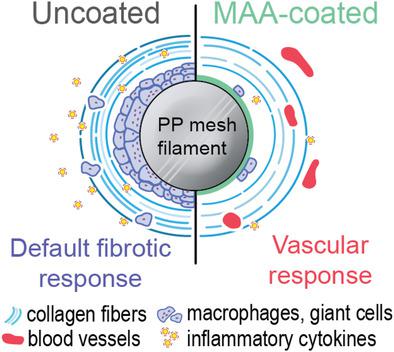当前位置:
X-MOL 学术
›
Adv. Healthcare Mater.
›
论文详情
Our official English website, www.x-mol.net, welcomes your
feedback! (Note: you will need to create a separate account there.)
Methacrylic Acid Copolymer Coating Enhances Constructive Remodeling of Polypropylene Mesh by Increasing the Vascular Response.
Advanced Healthcare Materials ( IF 10.0 ) Pub Date : 2019-08-13 , DOI: 10.1002/adhm.201900667 Virginie F Coindre 1 , Miranda M Carleton 1 , Michael V Sefton 1, 2
Advanced Healthcare Materials ( IF 10.0 ) Pub Date : 2019-08-13 , DOI: 10.1002/adhm.201900667 Virginie F Coindre 1 , Miranda M Carleton 1 , Michael V Sefton 1, 2
Affiliation

|
This study reports that a methacrylic acid (MAA)-based copolymer coating generates constructive remodeling of polypropylene (PP) surgical mesh in a subcutaneous model. This coating is non-bioresorbable and follows the architecture of the mesh without impeding connective tissue integration. Following implantation, the tissue response is biased toward vascularization instead of fibrosis. The vessel density around the MAA mesh is double that of the uncoated mesh two weeks after implantation. This initial vasculature regresses after two weeks while mature vessels remain, suggesting an enhanced healing response. Concurrently, the MAA coating alters the foreign body response to the mesh. Fewer infiltrating cells, macrophages, and foreign body giant cells are found at the tissue-material interface three weeks after implantation. The coating also dampens inflammation, with lower expression levels of pro-inflammatory and fibrogenic signals (e.g., Tgf-β1, Tnf-α, and Il1-β) and similar expression levels of anti-inflammatory cytokines (e.g., Il10 and Il6) compared to the uncoated mesh. Contrary to other coatings that aim to mitigate the foreign body response to PP mesh, a MAA coating does not require the addition of any biological agents to have an effect, making the coated mesh an attractive candidate for soft tissue repair.
中文翻译:

甲基丙烯酸共聚物涂料可通过增加血管反应来增强聚丙烯网的结构重塑。
这项研究报告说,基于甲基丙烯酸(MAA)的共聚物涂层可在皮下模型中对聚丙烯(PP)手术网产生建设性的重塑。这种涂层是不可生物吸收的,并且遵循网状结构,而不会阻碍结缔组织的整合。植入后,组织反应偏向于血管化而不是纤维化。植入后两周,MAA网孔周围的血管密度是未涂覆网孔的两倍。最初的脉管系统在两周后消退,而成熟的血管仍保留着,表明愈合反应增强。同时,MAA涂层会改变异物对网格的响应。植入后三周,在组织-材料界面发现较少的浸润细胞,巨噬细胞和异物巨细胞。涂层还可以减轻炎症,促炎和纤维化信号(例如Tgf-β1,Tnf-α和Il1-β)的表达水平较低,而抗炎细胞因子(例如Il10和Il6)的表达水平相近到未涂层的网格。与旨在减轻异物对PP筛网反应的其他涂料相反,MAA涂料不需要添加任何生物制剂即可发挥作用,从而使经涂覆的筛网成为软组织修复的诱人候选物。
更新日期:2019-08-13
中文翻译:

甲基丙烯酸共聚物涂料可通过增加血管反应来增强聚丙烯网的结构重塑。
这项研究报告说,基于甲基丙烯酸(MAA)的共聚物涂层可在皮下模型中对聚丙烯(PP)手术网产生建设性的重塑。这种涂层是不可生物吸收的,并且遵循网状结构,而不会阻碍结缔组织的整合。植入后,组织反应偏向于血管化而不是纤维化。植入后两周,MAA网孔周围的血管密度是未涂覆网孔的两倍。最初的脉管系统在两周后消退,而成熟的血管仍保留着,表明愈合反应增强。同时,MAA涂层会改变异物对网格的响应。植入后三周,在组织-材料界面发现较少的浸润细胞,巨噬细胞和异物巨细胞。涂层还可以减轻炎症,促炎和纤维化信号(例如Tgf-β1,Tnf-α和Il1-β)的表达水平较低,而抗炎细胞因子(例如Il10和Il6)的表达水平相近到未涂层的网格。与旨在减轻异物对PP筛网反应的其他涂料相反,MAA涂料不需要添加任何生物制剂即可发挥作用,从而使经涂覆的筛网成为软组织修复的诱人候选物。





















































 京公网安备 11010802027423号
京公网安备 11010802027423号